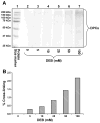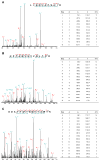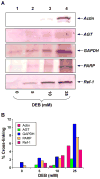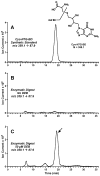DNA-protein cross-linking by 1,2,3,4-diepoxybutane
- PMID: 20666492
- PMCID: PMC2956319
- DOI: 10.1021/pr1000835
DNA-protein cross-linking by 1,2,3,4-diepoxybutane
Abstract
1,2,3,4-diepoxybutane (DEB) is a strongly genotoxic diepoxide hypothesized to be the ultimate carcinogenic metabolite of the common industrial chemical and environmental carcinogen 1,3-butadiene. DEB is a bis-electrophile capable of cross-linking cellular biomolecules to form DNA-DNA and DNA-protein cross-links (DPCs), which are thought to play a central role in its biological activity. Previous studies with recombinant proteins have shown that the biological outcomes of DEB-induced DPCs are strongly influenced by protein identities. The present work combines affinity capture methodology with mass spectrometry-based proteomics and immunological detection to identify the proteins that form DPCs in nuclear extracts from human cervical carcinoma (HeLa) cells. We identified 39 human proteins that form covalent DPCs in the presence of DEB. DNA-protein cross-linking efficiency following treatment with 25 mM DEB was 2-12%, depending on protein identity. High-performance liquid chromatography-electrospray ionization-tandem mass spectrometry (HPLC-ESI+-MS/MS) analysis of the total proteolytic digests of cross-linked proteins revealed the presence of 1-(S-cysteinyl)-4-(guan-7-yl)-2,3-butanediol conjugates, suggesting that DEB forms DPCs between cysteine thiols within proteins and the N-7 guanine positions within DNA.
Figures







References
-
- Barker S, Weinfeld M, Murray D. DNA-protein crosslinks: their induction, repair, and biological consequences. Mutat Res. 2005;589:111–135. - PubMed
-
- Dizdaroglu M, Gajewski E. Structure and mechanism of hydroxyl radical-induced formation of a DNA-protein cross-link involving thymine and lysine in nucleohistone. Cancer Res. 1989;49:3463–3467. - PubMed
-
- Dizdaroglu M, Gajewski E, Reddy P, Margolis SA. Structure of a hydroxyl radical induced DNA-protein cross-link involving thymine and tyrosine in nucleohistone. Biochemistry. 1989;28:3625–3628. - PubMed
-
- Barker S, Weinfeld M, Zheng J, Li L, Murray D. Identification of mammalian proteins cross-linked to DNA by ionizing radiation. J Biol Chem. 2005;280:33826–33838. - PubMed
Publication types
MeSH terms
Substances
Grants and funding
LinkOut - more resources
Full Text Sources
Miscellaneous

